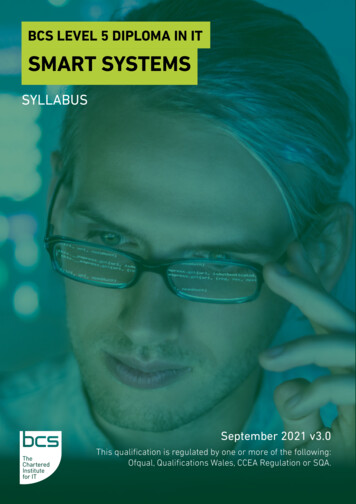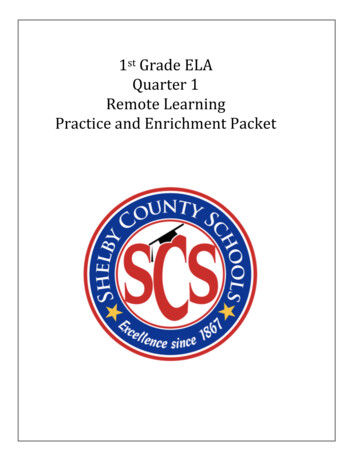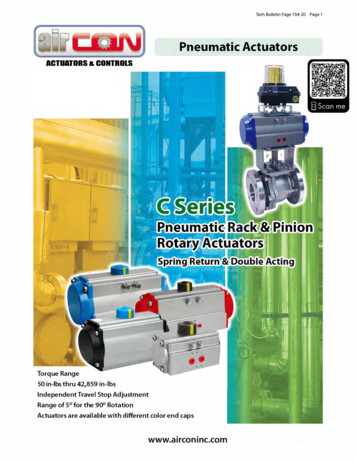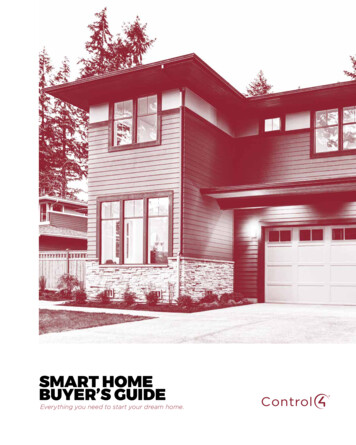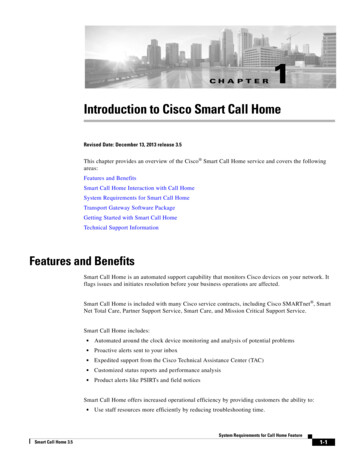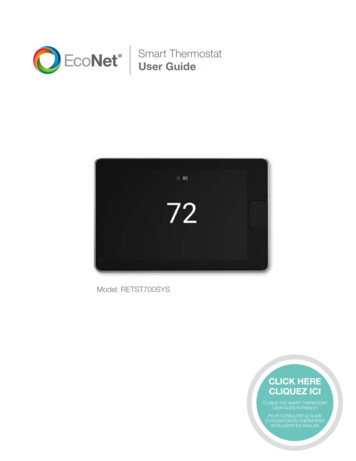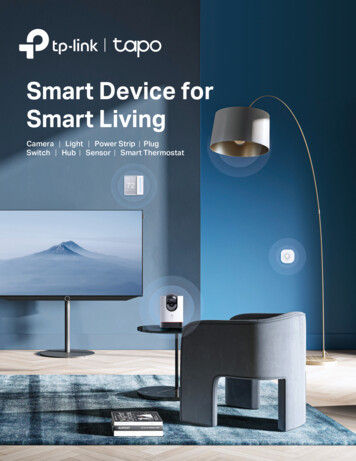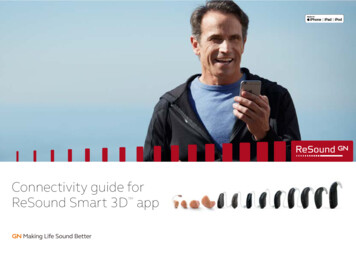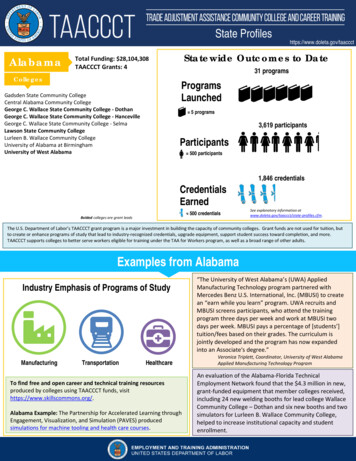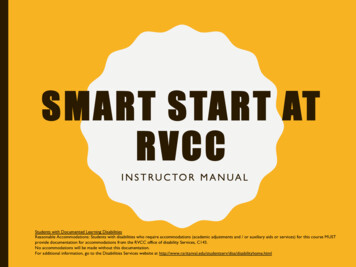
Transcription
SMART START ATRVCCI N S T R U C TO R M A N U A LStudents with Documented Learning DisabilitiesReasonable Accommodations: Students with disabilities who require accommodations (academic adjustments and / or auxiliary aids or services) for this course MUSTprovide documentation for accommodations from the RVCC office of disability Services, C143.No accommodations will be made without this documentation.For additional information, go to the Disabilities Services website at ityhome.html
RARITAN VALLEYCOMMUNITY COLLEGESite CoordinatorInieka StaffordInieka.stafford@raritanval.edu(908) 526-1200 x8519Job Skills SpecialistJoanna CapuanoJoanna.capuano@raritanval.edu(908) 526-1200 x8541Practicum SpecialistYshanda DentonYshanda.denton@raritanval.edu(908) 526-1200 ceEdReady Linkhttps://rvcc.edready.org
COUNTY COLLEGEOF MORRISSite CoordinatorBarbara McShanebmcshane@ccm.edu(973) 328-5735Job DeveloperDavid Choedchoe@ccm.edu(973) 328-5189Health Care althgrantEdReady Link:www.ccm.edready.org
MERCER COUNTYCOMMUNITY COLLEGESite CoordinatorMartha Redondoredondom@mccc.edu(609) 586-4800 x 3987Job DeveloperSara Smilowitzsmilowis@mccc.edu(609) 570-3121RecruiterAndrea Bashbasha@mccc.edu(609) 570-3122Health EdReady Linkwww.mccc.edready.org
BROOKDALECOMMUNITY COLLEGESite CoordinatorScott Shanessshanes@brookdalecc.edu(732) 224-2011Job Placement SpecialistGreg Menzagjmenza@brookdalecc.edu(732) 224-2503AdvisorDanielle Propertdpropert@brookdalecc.edu(732) 224-2685Continuing healthcare/EdReady Link:https://brookdale.edready.org/home
PASSAIC COUNTYCOMMUNITY COLLEGESite CoordinatorTanya Da Silvatdasilva@pccc.edu(973) 684-6606Job Developer/CareerCounselorSamantha Landwehrslandwehr@pccc.edu(973) 684-5606Passaic County CommunityCollegewww.pccc.edu/ceEdReady Linkhttps://pccc.edready.org
MIDDLESEXCOUNTY COLLEGESite CoordinatorMartin E. Schambergermschamberger@middlesexcc.edu(732) 548-6000 x3813Job DeveloperLina Bermanlberman@middlesexcc.edu(732) 548-6000 x3817AdvisorElliot Fishmanefishman@middlesexcc.edu(732) 548-6000 x3816Continuing Education ee-allied-health-training/EdReady Linkhttps://middlesexcc.edready.org/login
BERGENCOMMUNITY COLLEGESite CoordinatorSalwa Muhammadsmuhammad@bergen.edu(201) 301-1692Job DeveloperEllen Araminiearamini@bergen.edu(201) 301-9682Career CounselorChristina Sgambellonecsgambellone@bergen.edu(201) 447-8814Continuing cation/Course ation/courses-programs/EdReady Linkhttps://bergen.edready.org
CAREER MAPInsert an image of front and back of the Career Map – this can befound on Skills CommonsLink for Career 349
ADD IMAGE If doing on line Add screenshots and information for accessing onlinelearning platform that you will use to deploy course.
I AM A FUTUREHEALTH CAREPROFESSIONALS M A R T S TA R T AT R V C C – I N T R O D U C T I O N T OH E A LT H C A R E C A R E E R O P P O R T U N I T E S
SMART START CLASSES INTRODUCTION TO HEALTH CARE CAREERS WHO IS THIS CLASS FOR:HIGH SCHOOL STUDENT OVER 18 YEARS OF AGEUNEMPLOYED INDIVIDUALSUNDEREMPLOYED INDIVIDUALSINDIVIDUALS INTERESTED IN FIRST AND SECONDCAREERS
PURPOSE OF COURSE To provide information on the Health Care arena in the 21st century Introduce students to different Health Care careers Help student determine if they are interested in a Health Care careerpath Identify required preparation and education for several Health Careprofessions Identify where information on job locations, salary range can befound.
SMART START ATRVCC( D A YO N E )D AY O N E – W H Y S H O U L D Y O U B E C O M E AH E A LT H C A R E P R O F E S S I O N A L ?
DAY ONE OBJECTIVES Define health care in the 21st century Discuss ethical and legal issues in health care Define HIPPA Discuss specific health care professions Discuss how to get started in a health care career Discuss search of career opportunities, salaries and probable locations Preparation for required education Assessment of individual learning style
HEALTH CARE IN THECENTURYST21 4.2 MILLION INCREASE IN HEALTH CARE JOBS IS EXPECTEDBETWEEN 2010 AND 2020 63% OF THOSE INCREASED JOBS WILL BE IN efault/files/chws bls report 2012.pdf
LEGAL AND ETHICAL ISSUESETHICAL ISSUESLEGAL ISSUES ACCESS TO CARE MALPRACTICE END OF LIFE ISSUES INFORMED CONSENT DECISION-MAKING FORPEDIATRIC AND GERIATRICPATIENTS PATIENT CONFIDENTIALITY PATIENT WELFARE HEALTH INSURANCEPORTABILITY ANDACCOUNTABILITY ACT HIPAA
WHAT IS HIPAA?HEALTH INSURANCE PORTABILITY AND ACCOUNTABILITY ACT(HIPAA) PROTECTS PATIENT CONFIDENTIALITY HELPS PATIENTS MAINTAIN HEALTH INSURANCE PROTECTS THE CONFIDENTIALITY OF PATIENT HEALTHINFORMATION
HEALTH CARE PROFESSIONS ATHLETIC TRAINER* NURSE – RN*/LPN CARDIOVASCULAR TECHNOLOGIST NUTRITIONIST CERTIFIED NURSING ASSISTANT* OCCUPATIONAL/PHYSICAL THERAPIST CLINICAL CODER/MEDICAL CODER* OPHTHALMIC TECHNICIAN* DENTAL ASSISTANT*/HYGIENIST PHARMACY TECHNICIAN* EKG TECHNICIAN* PHLEBOTOMIST* EMT/PARAMEDIC RADIOGRAPHER HEALTH INFORMATIONTECHNOLOGIST* RESPIRATORY THERAPIST LANGUAGE INTERPRETOR SURGICAL TECHNICIAN MEDICAL ASSISTANT* SONOGRAPHER THERAPIST *COURSES/PROGRAMS CURRENTLY OFFERED AT RVCC
PROFESSIONAL ASSOCIATIONSAND WEBSITES Dental Hygienist http://www.adha.org EKG Technician –http://www.CAAHEP.org EMT - http://www.nremt.org EMT/Paramedic http://www.paramedicemttraining.com Language Interpretation http://ccie-accreditation.org Medical Assistant tants.htm New Jersey Board of Nursing www.state.nj.us/oag/ca/medical/nursing.htm National League for Nursing www.nln.org Occupational Therapy –www.acote.org American Association ofRespiratory Care – www.aarc.org Association of Surgical Technologists– http://www.ast.org
GETTING STARTEDWHAT INFORMATION DOI NEED? Career Opportunities Job locations Salary Ranges Required educationW H E R E TO L O O K F O RI N F O R M AT I O N ? – L O C AT E D O NRV C C L I O N ’ S D E N
ADD RESOURCES Add resources that your college uses for career services and careerplanning that students may want to visit.
WHO WILL BE MY CLIENTS?What Do You See When You Look At Me Nursewww.youtube.com/watch?v LOtNdn GsMc"IF WE COULD SEE INSIDE OTHERS' HEARTS": LIFE, in 4 minhttps://www.youtube.com/watch?v Wl2 knlv xw
WHAT IS MY LEARNINGSTYLE? Auditory Learner Visual Learner Kinesthetic Learner Take a free learning style inventory at Pennsylvania State I.htm
SMART START ATRVCC(DAY TWO)D AY T W O – P R O F E S S I O N A L I S M A N DI N T R O D U C T I O N TO T H E L A N G UAG E O FMEDICINE
DAY TWO OBJECTIVES Define professionalism Discuss transition from student to employeeResume writing, Job interview Discuss components of EXCELLENT customer serviceAccountability, Attitude, Reliability,Verbal and Written Communication Introduce medical terminologyMedical Terms, Acceptable Abbreviations, Body Systems Demonstrate use of the military clock
PROFESSIONALISM – WHATIS IT? Definitions Components of Professions Professional Requirements
WHAT IS A PROFESSIONALTO YOU? List characteristics that you have observed in the past?
TRANSITIONALROLE FROMSTUDENT TOPROFESSIONAL
TRANSITION FROM STUDENT TO EMPLOYEE
KEYS TO SUCCESS FOR NEWHEALTHCARE PROFESSIONALS CRITICAL THINKING SKILLS PROBLEM-SOLVING SKILLS PRIORITIZATION MOTIVATION TEAM WORK, SENSE OF COMMUNITY
SUCCESS ON LICENSINGAND CERTIFICATION EXAMS STUDY, STUDY, STUDY EVALUATE YOUR LEARNING AND STUDY STYLES ENROLL IN A REVIEW COURSE IF AVAILABLE PRACTICE QUESTIONS PREPARE PHYSICALLY AND MENTALLY FOR EXAM (Rest, Sleep,Food)
GETTING THE JOB THE RESUME PRE-INTERVIEW, DO YOUR HOMEWORK THE INTERVIEW DRESS CODE AND BEHAVIOR POST-INTERVIEW
IS THIS THE JOB FOR ME? URBAN vs. RURAL, INNER CITY vs. COMMUNITY HOSPITAL CLINICS, PHYSICIAN’S OFFICES, LABORATORIES, SCHOOLS AVAILABLE POSITIONS,VARIED PRACTICE SETTINGS ORIENTATION COMPENSATION, BENEFITS TRAVEL DISTANCE AND TIME
KEEP GROWING! CONTINUING EDUCATION, JOURNALS, CONVENTIONS,SEMINARS, WORKSHOPS SPECIALTY CERTIFICATIONS HIGHER EDUCATION INSTITUTIONS AND PROGRAMS PROFESSIONAL ASSOCIATIONS SHARING WITH COLLEAGUES NEW AND ONGOING RESEARCH
GOALS WHERE DO I SEE MYSELF IN .1 YEAR?5 YEARS?10 YEARS?
MOLD YOUR CAREERS! Transition from Student to Health Care Professional is challenging andoften has many steps along the way Face change head on with a clear, focused plan . Go forth and mold your careers and your life!
ADD RESOURCE Insert Networking session PowerPoint ‘Writing the Effective Resume.’This can be found on Skills Commons Link: https://www.skillscommons.org/handle/taaccct/8715
QUESTIONS &ANSWERS
ADD RESOURCES(PG. 2) Insert the Slides and presentation materials on “6 Secrets to Writing aGreat Cover Letter which can be found on Skills Commons Link: https://www.skillscommons.org/handle/taaccct/8601
SMART START ATRVCC(CUSTOMER SERVICE)C U S TO M E R S E RV I C E
COMPONENTS OFCUSTOMER SERVICE Accountability Reliability Verbal and Written Communication https://www.youtube.com/watch?v y2Z4OEhufTQ https://www.youtube.com/watch?v W1RY 72O LQ Hospital Consumer Assessment of Healthcare Providers and Systems(HCAHPS) https://www.youtube.com/watch?v 0jPk6CtK360 Exercise: Can you give an example of good customer service?
COMMUNICATION EXERCISE Reflection Exercise : Think about a time youmisinterpreted communication. Think about how easy andcommon it is to misinterpret messages. Think also oftimes when you have said – “Well, had I known that, Iwould have ?” This is a classic example of gaps incommunication.
CONFLICT RESOLUTION Assertive vs. Aggressive behavior Cool down before discussing conflict with those involved Use assertive communication to discuss the issue, problem-solve andstrive for a win-win solution
CULTURE IS Culture Culture and Health Care
SMART START ATRVCC(INTRO)I N T R O D U C T I O N TO M E D I C A L T E R M I N O L O G Y
MEDICAL TERMINOLOGY WORD PARTS MEANINGS MEDICAL DICTIONARY PRONUNCIATION SPELLING ABBREVIATIONS
WORD ANALYSIS PREFIXES WORD ROOTS/COMBINING FORM SUFFIXES
WHEN ANALYZING WORDS BEGIN AT THE END LOOK AT THE WORD PARTS IN THIS ORDER:1. SUFFIX2. PREFIX3. ROOT(S)
SUFFIXESUNIT(S) OF MEANING ATTACHED TO THE END OF WORD THATCHANGE THE MEANING OF A WORD OR CREATE A NEWWORD
SUFFIXES THAT CHANGES AROOT WORD TO A NOUN -CIDE killer -GEN production of -ICIAN one charged with -IST skilled in -METER measure -PHYLAXIS protection
SUFFIXES THAT CHANGES AROOT WORD TO AN ADJECTIVE -AC, -IC, -ARY, - AL, -ACY pertaining to -AD toward, in direction of -AN pertaining to, belonging to -AR of, related to, pertaining to -ILE capable of, having qualities of -IOUS capable of, causing -OID like
SUFFIXES THAT DENOTES ADISEASE PROCESS -AGRA severe pain -ALGIA pain -ATRESIS abnormal closure -CELE swelling, bulging, tumor -CHEZIA, -CHESIA discharge of foreign substance -DYNIA pain -EMA swelling, distention
MORE SUFFIXES THAT DENOTESA DISEASE PROCESS -IA, -IASIS disease, condition -ITIS inflammation -PATHY suffering, disease -PENIA deficiency -RRHAGE, -RRHAGIA bursting forth -RRHEA flow, discharge
SUFFIXES THAT INDICATES ASURGICAL OR DIAGNOSTICPROCEDURE -CENTESIS puncture of cavity-CIS cut-CLASTIC breaking-CLEISIS closure-DESIS binding, fusion-ECTOMY excision, cutting out-OSTOMY creation of a mouth or opening-OTOMY cutting into-TRIPSY rubbing, crushing
SUFFIXES THAT INDICATESSMALLEST -CULUS, -CULUM, -CULE, -OLE, -OLUS indicates the smallest
NOT TRUE SUFFIXES BUT CHANGE THEMEANING OF THE WORD CHEMICAL COMPOUNDS:-ASE enzyme-ATE salt made from an acid DENOTING A CONDITION-FUL full of-ID condition-NESS state of being-OSIS condition
PLURALS/PLURALS OFNOUNS SINGULAR PLURAL-A-AE-EN-INA-EX-ICES-OS or –US-I-ON or -UM-ES or -A
PREFIXESUNIT(S) OF MEANING ATTACHED TO THE FRONT OF A WORDTHAT CAN CHANGE THE MEANING OF THE WORD ORCREATE A NEW WORD
PREFIXES - RELATED TOPOSITION REGARDING TIMEAND PLACE ANA- up, back again ANTE- before NOCT(I)- night PRIM- first TER(T)- third
PREFIXES - DESCRIBINGPOSITION OR LOCATION ACRO- extremity, tip CIRCUM- around CONTRA- opposite, against JUXTA- near MEDI-, MESO- middle
PREFIXES - RELATED TO TYPE BRADY- slow TACHY- fast MAL- bad PATH(O)- disease, suffering
PREFIXES - DESCRIBINGDIRECTION AB- away AD- to, toward DEXTRO- right LEVO- left PRO- forward, anterior RETRO- behind, backward
PREFIXES - DESCRIBINGNUMBER AND QUANTITY BI- two AMBI-, AMPHI- both DEMI-, HEMI- one-half MONO- one PAN- all POLY- many
PREFIXES - RELATED TO SIZEAND AMOUNT AN-, A- none ANIS(E)- unequal MACRO-, MEGA- large MICRO- small OLIGO- scant
PREFIXES - DENOTINGCOLOR ALBA-, LEUKO- white CHLORO- green CHROMO- color CYANO- blue ERYTHRO-, RUBE- red LUTE-, XANTHO- yellow MELANO-, NIGRO- black
DENOTING SHAPE ORTHO- straight PLATY-, EURY- broad, flat PACHY- thick
PREFIXES - DENOTING #’S INASCENDING ORDER MONO- one BI- two TRI- three
WORD ROOTS/COMBININGFORMS WORD ROOT(S) - Foundation of word’s meaning, can sometimesstand by itself as a separate word COMBINING VOWELS - A vowel added to the end of the root COMBINING FORMS – The root(s) and combining voweltogether
IDENTIFICATION AND SPELLING OF MEDICALWORDS IF THE SUFFIX BEGINS WITH A VOWEL, DROP THECOMBINING VOWEL AND ADD THE SUFFIX IF THE SUFFIX BEGINS WITH A CONSONANT, KEEP THECOMBINING VOWEL AND ADD THE SUFFIX KEEP THE COMBINING VOWEL BETWEEN TWO OR MOREWORD ROOTS
MEDICAL TERMINOLOGYHINTS PREFIXES AND SUFFIXES – Many have multiple meanings. SPELLING – Words of Greek origin can be difficult to spell because ofsilent letters IMPORTANCE OF CORRECT SPELLING – An addition or omissionof letter(s) can change the meaning of the word
SMART START ATRVCC(A&P)A N AT O M Y A N D P H Y S I O L O G Y
ANATOMY AND PHYSIOLOGY ANATOMY: PHYSIOLOGY:Study of bodystructures andtheir organizationStudy of the processesand functions of thebody
ORGANIZATION OFSTRUCTURES ORGANISM CELLS TISSUES ORGANS SYSTEMS
LOCATIONAL TERMS POSITIONAL AND DIRECTIONAL TERMS PLANES OF THE BODY QUADRANTS AND REGIONS
POSITIONAL ANDDIRECTIONAL TERMS SUPINE/PRONE LATERALLY SUPERIOR/INFERIOR ANTERIOR/POSTERIOR MEDIAL PROXIMAL/DISTAL SUPERFICIAL/DEEP
BODY PLANES FRONTAL SAGITTAL TRANSVERSE
QUADRANTS AND REGIONS RIGHT UPPER QUADRANTLEFT UPPER QUADRANTRIGHT LOWER QUADRANTLEFT LOWER QUADRANTNINE REGIONS – RIGHT AND LEFT HYPOCHONDRIAC,EPIGASTRIC, RIGHT AND LEFT LUMBAR, UMBILICAL, RIGHTAND LEFT INGUINAL, HYPOGASTRIC
BODY CAVITIES DORSAL CAVITY – cranial and spinal cavity VENTRAL CAVITY – body organs, peritoneum
CYTOLOGY CELL STRUCTURE GENETICS GENETIC DISORDERS GENETIC COUNSELING CONGENITAL DISORDERS
HISTOLOGY STEM CELLS TISSUES – epithelial, connective, muscle and nerve TISSUE FORMATION – aplasia, hypoplasia, hyperplasia, dysplasia,anaplasia
PATHOLOGY TYPES OF DISEASES DISEASE TRANSMISSION OUTBREAK OF DISEASES
MAJOR BODY SYSTEMS SKELETAL URINARY MUSCULAR NERVOUS CARDIOVASCULAR INTEGUMENTARY RESPIRATORY ENDOCRINE LYMPHATIC ANDIMMUNE REPRODUCTIVE DIGESTIVE
SMART START ATRVCC(DAY 3)D AY T H R E E – T E C H N O L O G Y I N H E A LT H C A R EA N D M E D I C A L M AT H E M AT I C S
DAY THREE OBJECTIVES Discuss the role of technology in health careElectronic Health Records, portals, medical equipment, research Discuss safety principles of medication administration Discuss the concept of polypharmacy Identify pertinent information on medication labels Utilize medical math calculations to determine correct medicationdoses Discuss common medication interactions and potential side effects
ROLE OF TECHNOLOGY ELECTRONIC HEALTH RECORDS HEALTH INFORMATION PORTALS MEDICAL EQUIPMENT – ELECTRONIC THERMOMETERS, BLOODPRESSURE MACHINES, TELEPHONIC MEDICINE, MONITORS,DAVINCI ROBOTIC SURGERY
M E D I C AT I O N A D M I N I S T R AT I O N
PRINCIPLES Right patient Right medication Right dose Right route Right time Right documentation
ORAL ROUTE OF MEDICATION ADMINISTRATIONADVANTAGES OF ORALROUTE Easy Most common method Many choices RetrievableDISADVANTAGES OFORAL ROUTE Requires the patientparticipate Slower onset Prolonged effect Less Anxiety Potential drug to drug or drugto food reactions No Pain Aspiration Risk No Break in the Skin GI Irritation
ORAL MEDICATIONS ASSESS patient’s ability to swallow safely Plan: expected outcomes, crush or not, needs of patient, equipment,position, education Implement: gather equipment, position, educate, Evaluate: knowledge, side effects, effects,
CASE STUDY An 83 year old patient given Cardizem CD. The capsule was too largeto swallow so the patient chewed it. She became weak, bradycardicand died!!!!!! WHY? What is polypharmacy? How would this impact on the 83 year oldpatient above?
M E D I C AT I O NLABELSLook at this Over-the- Countermedication label Find the specific uses of thismedication.What are the potential sideeffects?How frequently should thismedication be taken?What is the correct dose forchildren 6-12 years old?What does the Warnings mean?Medical label d-otcdrug-facts-label.html92
DAT EM E D I C A L M AT H C A L C U L AT I O N Q U E S T I O N SNAME4.6. Patient’s dose is 750 mg. On hand is 250mg tablets. How many tablets should thepatient receive?Patient’s dose is 30 mg. On hand are 10mg tablets. How many tablet(s) shouldthe patient receive?2. 2 grams ? mgS H OW A L L YO U R WO R K A N D C I R C L E YO U R A N S W E R S .1.Patient’s dose is 40 mg. On hand are20 mg tablets. How many tablet(s)should the patient receive?3. Patient’s dose is 20 mg. On hand ismedication 40 mg in 5 mL. Howmany mL should the patient receive?5. Patient’s dose is 5 mg. On hand are 10mg tablets. How many tablets shouldthe patient receive?93
10. 500 mg ? grams9. 300 mg ? GramsM E D I C A L M AT H C A L C U L AT I O N Q U E S T I O N S C O N T I N U E D7. Patient’s dose is 50 mg. On handare 20 mg tablets. How manytablet(s) should the patient receive?8. Patient’s dose is 7.5 mg. On handare 2.5 mg tablets. How manytablet(s) should the patient receive?94
MEDICAL MATHCALCUL ATIONSS E E H A N D O U T S F O R M AT HQ U E S T I O N S T O S O LV E
MEDICAL MATH CALCULATIONS– CONVERSIONS AND FORMULA CONVERSIONS1 gram (g) 1000milligrams (mg)1 kilogram (kg) 1000 grams (g)1 kilogram (kg) 2.2 pounds (lbs)1 teaspoon (tsp) 5milliliters (mL)1 tablespoon (tbsp) 15 milliliters (mL)1 tbsp 3 tsp1 ounce (oz) 30mL12 oz 360 mL1 cup 8 oz 240mL FORMULAD (dose desired) X Quantity amount to giveH (what on hand)96
MEASURE CONVERSIONCHART – WEIGHT (UK)Use this link to access the MeasureConversion Chart for Weight asureconversion-chart-uk-weight.gif97
COMMON MEDICATIONINTERACTIONS AND SIDEEFFECTSCOMMONINTERACTIONS DRUG –DRUGINTERACTIONS DRUG-FOOD/BEVERAGEINTERACTIONS DRUG-CONDITIONSCOMMON SIDE EFFECTS ALLERGIC REACTION –ITCHING, RASH,ANAPHYLACTIC SHOCK BLEEDING NAUSEA AND VOMITING DIARRHEA, drug-side-effects-explained
SMART START ATRVCC(DAY 4)D AY F O U R – PAT I E N T S A F E T Y, I N F E C T I O NCONTROL AND CLINICAL COMPETENCIES99
DAY FOUR OBJECTIVES Define Infection Control and Infection Control procedures Discuss Patient Safety and the Joint Commission’s National PatientSafety Goals Demonstration and correct Return Demonstration of specific clinicalcompetenciesHandwashing, Application, Removal and Disposal of PPE, Measureaccurate Vital Signs (Blood pressure, Pulse, Respiration andTemperature) Identify common conditions and medications for which vital signmonitoring is indicated
INFECTIONCONTROLH A N DWA S H I N G , M A S K , G OW N A N D G L OV E S !
CHAIN OF INFECTION INFECTIOUS AGENT SOURCE (RESERVOIR) PORTAL OF EXIT TRANSMISSION PORTAL OF ENTRY SUSCEPTABLE HOST
ADD IMAGE(PT. 2) Add image of your choice of chain of infection103
STANDARD PRECAUTIONS BLOOD AND BODY FLUIDS APPROPRIATE PROTECTIVE WEAR HANDWASHING STORAGE OF CONTAMINATED WASTE PROPER DISPOSAL OF SHARPS SPECIFIC ISOLATION PROCEDURES
ISOLATION – TRANSMISSION-BASED PRECAUTIONS CONTACT ISOLATION DROPLET AIRBORNE STRICT PROTECTIVE (NEUTROPENIC)
“IF IT IS WET-WEARGLOVES”
MEDICAL ASEPSIS DEFINITION WAYS TO PROMOTE MEDICAL ASEPSIS DISINFECTANTS ANTISEPTICS
PAT I E N TSAFETY ANDINFECTIONCONTROLThe Joint Commission’s National PatientSafety Goals are reviewed and updatedfrequently. There are updates 2016 goals:Goal 1 – accuracy of patient ID continues.Goal 2 – Caregiver communication issuescontinues.Goal 3 – Safety of medication administrationcontinues.Goal 6 – Reduce harm related to clinicalalarms returns.Goal 7 – Reduce risk of Healthcareassociated infections returns.Goal 9 – Reduce risk of patient harm fromfalls continues.Goal 14 – Reduce hospital-acquired pressureulcers returns.Goal 15 – Identify safety risks inherent inpatient population continues.108
SKILLS/TECHNIQUES HANDWASHING PERSONAL PROTECTIVE EQUIPMENT (PPE)MaskGownGloves
VITAL SIGNS
THE VITAL SIGNS Temperature Pulse Respiration Blood Pressure Most Hospitals Also RequireAssessment of:– Pain Level– Pulse Oximetry
TEMPERATURE - WAYS TO TAKETEMPERATURE Oral Rectal Axillary Ear/Tympanic Forehead (Temporal Artery)
TEMPERATURE -BODY TEMPVARIATIONS Afebrile: without elevation in body temp Pyrexia: a body temp above normal Hypothermia: decreased body temp , death may occur below 34degrees C. Febrile: elevated body temp Core temp: temp of deepest tissues of body. i.e.: cranium, thorax,abdomen & pelvic cavity. 98.6F. Is constant
TEMPERATURE - SIGNS & SYMPTOMS OF FEVER Increase temperature Increase heart rate Increase respiratory & depth Shivering Cold skin Cyanotic nail beds Goosebumps
PULSE - METHODS OF PULSEASSESSMENT Palpation Auscultation
ADD IMAGE HERE Add image of your choice showing areas on the human body forpulse.116
PULSE - VARIATIONS Bradycardia: heart rate less than 60/min Tachycardia: heart rate greater than 100/min Dysrhythmia: irregular heart rate Pulse Deficit: deficit in pulse to the peripheral pulse site (assess 2sites at same time)
PULSESPULSE QUALITY Absent pulse ThreadyPULSE CHARACTERISTICS Rate Rhythm Weak Normal Bounding Pulse Deficit
PULSE - FACTORS THAT INFLUENCE PULSE RATE INCREASES: short term exercise, fever, heat, acute pain, drugs,hemorrhage, postural changes, COPD, asthma, hypoxia. DECREASES: conditioned athlete, hypothermia, unrelieved severe pain,relaxation, medications, lying down.
RESPIRATIONS - CHARACTERISTICS OFRESPIRATIONS Depth: degree of movement of the chest wall Rhythm: observe chest or abdomen Rate: Adult, 12-20/min: Child 20-30/min: Newborn 30-60/min
FACTORS INFLUENCE CHARACTER OFRESPIRATIONSExercise, increases rate and depthPain, shallowAnxiety, increase rate and depthSmoking, increases rateBody position, straight promotes full chest expansion: slumped –impairs: flat-prevents full chest expansion Medications: decrease or increase rate and depth Brain injury: decrease rate and depth
TYPES OF ABNORMAL BREATHING Bradypnea Tachypnea Apnea Dyspnea Cheyne Stokes Wheeze Stridor
BLOOD PRESSURE Systolic: reflects contraction of ventricles Diastolic: reflects relaxation of ventricles
WHAT FACTORS INFLUENCE BLOOD PRESSURE Age: older adults have rise in systolic pressure related to decrease invessel elasticity Circulating Volume Stress: sympathetic stimulation, increases Ethnicity: HTN highest in African-Americans and develop at youngerage Medications: multiple increase and/or decrease
ASSESSING BLOODPRESSURE SITES– Upper Extremity– Lower Extremity EQUIPMENT– Stethoscope– Doppler/Ultrasound– Automated Devices
BLOOD PRESSURE SKILL Proper Cuff Size Proper Patient Positioning Palpation
HYPERTENSION Hypertension: usually asymptomatic, takes years,thickening and loss of elasticity in the arterial wallswhich decreases blood flow to vital organs causingdamage. Risk factors: family hx(history), cigarette,heavy alcohol, high sodium intake, sedentary lifestyle,diabetic, old, African-Americans.
HYPOTENSION When systolic BP below 90mm, Dilation of the arteries in the vascularbed, loss of a substantial amount of blood volume (hemorrhage), orfailure of the heart muscle to pump adequately (MI).
SIGNS & SYMPTOMS OF HYPOTENSION Pallor Skin mottling Clamminess Confusion Increased heart rate Decreased urine output
OTHER ASSESSMENTS PAIN LEVEL– The 5th Vital Sign– Use of Appropriate Pain Scale PULSE OXIMETRY– Measures Oxygen Concentration in Hgb
#Prepare and assess hands.ProcedureCompetent Not CompetentSKILL: HANDWASHING1.Turn on water and adjust flow andtemperature.Check hands for breaks in skin, file nails short andremove all jewelry2.Wet hands thoroughly and apply soap.Thoroughly wash and rinse hands.Hold hands lower than the elbows so water flowsfrom arms to fingertips.3.4.5.Thoroughly dry hands and arms withpaper towel from finger tips towardsarm. Discard paper towel in appropriatereceptacle.Use firm, rubbing, circular movements. Washpalm, back, and wrist of each hand. Interlacefingers and thumbs, and move hands back andforth for 15-30 seconds.6.Turn off water using dry, clean papertowel.
A P P LY I N G A N D R E M O V I N G P E R S O N A L P R O T E C T I V E E Q U I P M E N T5.4.3.ba2.1.REMOVING PPE: Remove gloves first.First glove is removed by using opposite hand to graspsoiled glove at palmar surface and rolling the glove insideout. Hold removed soiled gloves with fingers of remaininggloved hand. To remove second glove, place first twofingers of bare hand inside the cuff of glove. Pull secondglove off to the fingers by turning inside out. The resultswill be that the first soiled glove is now inside the secondremoved glove. Dispose removed gloves in appropriatecontainer without contaminating bare hands. Wash ifapplicable.Don clean disposable gloves. Pull gloves over cuffs ofgownDon the face mask. Look for top edge of mask, hold by toptwo strings. Place top edge of mask over the bridge of thenose and tie upper two strings at back of head. Place loweredge of mask under chin and tie the lower strings at nape ofneck.Put arms and hands through sleeves. Tie the strings at the neck first tokeep gown in place. Overlap the gown at the back and tie the stringsat the waist.When picking up clean gown, do not allow it to touch contaminatedarea(s). Unfold the gown in front of you, avoiding touching the floor.Don clean gown.APPLYING PPEProcedure6.Remove gown: Untie waist strings in the back. Touchinggown along the inside of the neck, pull it down theshoulders. Roll up gown with soiled part on the inside anddiscard in appropriate container.#7.Remove mask: Untie lower strings, then upper strings.Hold upper strings and remove mask without touching frontof mask. Discard in appropriate container withoutcontaminating self. Perform hand hygiene.CompetentNotCompetent
A S S E S S I N G V I TA L S I G N S 1 O F 31.Assessing Body Temperature using an electronic/digitalthermometerProcedureaPerform Hand Hygiene and Identify Patient and ProvidePrivacy.Determine method of taking temperature.For Oral Temperature – determine if patient has taken inoral fluids or smoked recently. Remove thermometer fromcharger if necessary. Remove temperature probe ifnecessary. Place disposable cover securely on probe. Taketemperature by placing probe at below of tongue into theposterior sublingual pocket. Listen for sound indicatingcompletion of reading. Remove thermometer and recordtemperature reading. Remove and discard probe cover.Return thermometer to battery charger if necessary.Variation:For Rectal Temperature – Place disposable cover on probeand then place lubricant on it.Wearing clean gloves, raise patient’s upper buttock toexpose anus. Ask patient to take a deep breath and insertprobe into anus.Variation:Place disposable cover on probe and then place in patient’saxilla. Have patient place his/her arm tightly across chest.#2.Assessing a Peripheral PulsePerform Hand Hygiene and Identify Patient and ProvidePrivacy.Select pulse point.Position patient comfortably.Palpate and count pulse using two or three middle fingerslightly over pulse point.Competent NotCompetent
#2.ASSESSING VITAL SIGNS 2 OF 3Procedure3.Assessing an Apical Pulse: Perform Hand Hygiene andIdentify Patient and Provide Privacy. Position patient intosupine or sitting position. Locate apex of patient’s heart.Ausculate with stethoscope and count beats (clean earpiecesand diaphragm of stethoscope with antiseptic wipes beforeand after assessment). Document findings.Count for 30 seconds and multiply by 2. If pulse is irregularcount
technologist* language interpretor medical assistant* nurse -rn*/lpn nutritionist occupational/physical therapist ophthalmic technician* pharmacy technician* phlebotomist* radiographer respiratory therapist sonographer surgical technician therapist *courses/programs currently offered at rvcc
